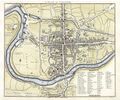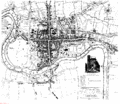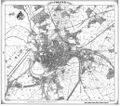Hunter Map
James Hunter (1752-1826), after whom Hunter Street is named, was an engraver who lived and worked in Chester, mostly around the Chester Cathedral - in Eastgate St, Northgate St, Werburghs Church-yard. Historical directories also list him as a carver, gilder and copperplate printer. In about 1815 Hunter had rooms with the miniature painter and silhouettist Albin R Burt, at the end of what is now Hunter Street. A "1789 Survey of the Ancient & Loyal City of Chester", surveyed by noted local canal engineer Samuel Weston was engraved and published by Hunter - which seems a little strange as Weston left Chester for the south of England after 1774 and in 1788-89 was surveying the Western Thames Canal.
Features
By the 1730s shipping at Chester had fallen to around 1,650 tons (a tenth of Liverpool's total) and in the late 1750s Chester's 1,000-1,400 tons was scarcely a twentieth of Liverpool's fleet. Efforts were made to improve the Dee by dredging a "new cut" in the estuary and cutting the canal, but the decline of traditional industry and trade continued. New life would stir at the Portpool at about the time of Hunter's map.
- The Canal has just appeared, but does not yet have the Dee Basin. It was conected to the River Dee in 1776. New Crane wharf at the Portpool was completed in 1772. The old Bridgegate had been demolished in 1781 and replaced. In 1788 the old Watergate was demolished and replaced.
- Queen Street now links Foregate Street with the Canal. "The Bars" a narrow postern in the outer defences at Boughton was demolished in 1770. The old Eastgate had been demolished (1769) and the present one replaced it;
- The Gaol at Chester Castle is shown for the first time, work on it had started in 1788;
- The Linenhall (1778) has opened in Stanley Street;
A gallery of Old Maps of Chester
Braun and Hogenberg (1581)
Smith Map (c.1588)
John Speed (c.1610)
Hollar's Map (1660's)
Lavaux Map (1745)
Hunter Map (1789)
Mutlow and StockdaIes Map (1795)
Coles Map (c.1804)
John Webb Map (1833)
Hugh Roberts (1858)


















